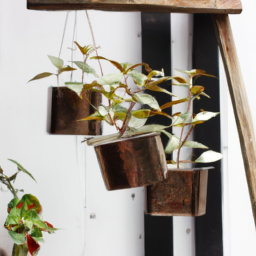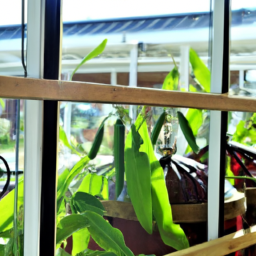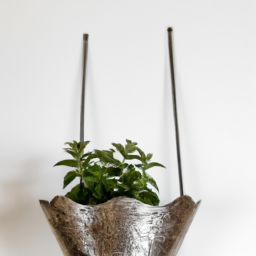
Are you tired of the same old boring planters for your indoor garden? Well, you’re in luck! In this blog post, we will explore a variety of unique planters that will add a touch of personality and style to your indoor space. From repurposed items to sleek and modern designs, we have got you covered. So, if you’re ready to elevate your indoor gardening game, keep reading to discover the perfect planter for your green companions. Unique Planters for Indoor Gardens: From Repurposed to Modern Designs.
Repurposed Materials: Creative Ideas for Unique Indoor Planters
Indoor gardening has become increasingly popular in recent years, and one way to add a unique touch to your indoor garden is by using repurposed materials as planters. Not only does this approach help you reduce waste and contribute to a more sustainable lifestyle, but it also adds a charming and distinctive element to your home decor. In this guide, we will explore creative ideas for repurposed planters that will transform your indoor garden into a visually captivating and eco-friendly space.
1. Vintage Tea Tins
One of the simplest yet most effective ways to repurpose materials for indoor planters is by using vintage tea tins. These tins not only provide a nostalgic and rustic aesthetic, but they also come in various sizes and designs, allowing you to mix and match them to create an eclectic collection of planters. To use vintage tea tins as planters, ensure they have drainage holes at the bottom to prevent waterlogging. Simply add some potting soil and your favorite indoor plants, and voila! You have a unique planter that adds character to your indoor garden.
When selecting vintage tea tins, keep an eye out for ones with intricate patterns or vibrant colors that complement your overall interior design. You can find these tins at thrift stores, flea markets, or even in your own kitchen cabinets. The possibilities are endless, and each tin tells a story of its own.
It’s important to note that vintage tea tins may not be suitable for plants that require a large amount of soil or have extensive root systems. Instead, opt for small succulents, herbs, or trailing plants that thrive in compact environments.
2. Upcycled Wine Bottles
If you’re a wine enthusiast, why not repurpose your empty wine bottles into stylish indoor planters? Upcycling wine bottles not only gives them a new lease of life but also adds an elegant and modern touch to your indoor garden. To transform a wine bottle into a planter, start by thoroughly cleaning and removing any labels or adhesive residue.
Next, carefully cut off the top part of the bottle using a glass cutter or a specialized bottle-cutting tool. Sand down the edges to ensure they are smooth and safe to handle. You can now fill the bottom of the bottle with a layer of pebbles or small rocks for drainage, followed by potting soil and your desired plants.
Wine bottle planters work particularly well for plants with long, trailing vines, such as pothos or philodendron. Their slender shape and transparency allow the vines to cascade beautifully, creating a visually striking display. Place them on a windowsill or hang them using macrame hangers for an added touch of elegance.
3. Vintage Suitcases
For a truly unique and eye-catching planter, repurpose a vintage suitcase. Vintage suitcases not only add a touch of nostalgia and charm to your indoor garden but also provide ample space for larger plants or even a mini herb garden. To transform a vintage suitcase into a planter, start by lining the bottom with a plastic sheet to prevent water from seeping through.
Next, add a layer of gravel or small pebbles for drainage, followed by a mixture of potting soil and compost. Depending on the size of the suitcase, you can either plant directly into the soil or use individual pots for your plants. Mix and match different plant varieties to create a visually appealing arrangement.
When selecting a vintage suitcase, consider its condition and sturdiness. Ensure that it is still functional and can withstand the weight of the soil and plants. You can find vintage suitcases at thrift stores, antique shops, or online marketplaces.
Remember to place your suitcase planter in a well-lit area, as most indoor plants require adequate sunlight to thrive. Additionally, be mindful of watering your plants, as suitcases may not have drainage holes. Monitor the moisture levels and adjust your watering routine accordingly to prevent waterlogging.
Repurposing materials for indoor planters not only adds a unique touch to your indoor garden but also promotes sustainability and creativity. By thinking outside the box and utilizing items that would otherwise go to waste, you can create a visually captivating and eco-friendly space that reflects your personal style. So, don’t be afraid to explore your surroundings and discover hidden potential in everyday objects. Happy gardening!

Modern and Stylish Designs for Indoor Planters: Adding a Contemporary Touch to Your Home
Indoor gardening has become increasingly popular in recent years, as more people are discovering the benefits of bringing nature indoors. Not only does it add a touch of greenery to your home, but it also improves air quality and creates a calming ambiance. One way to elevate your indoor garden is by choosing unique and modern planters that not only serve as functional vessels for your plants but also add a contemporary touch to your home decor. In this article, we will explore various modern and stylish designs for indoor planters, from repurposed to modern designs, that will help you create a stunning indoor garden.
Repurposed Materials: Adding Sustainability and Character
Repurposed planters offer a sustainable and eco-friendly option for indoor gardening. By giving new life to old objects, you not only reduce waste but also add a unique touch to your indoor garden. One popular repurposed planter idea is using vintage tea tins. These charming containers can be easily transformed into planters by adding drainage holes and filling them with soil. Not only do they look adorable, but they also add a nostalgic and whimsical vibe to your indoor garden.
Another repurposed planter option is using old mason jars. These versatile glass containers can be painted, decorated, or left as is, depending on your desired aesthetic. They are perfect for small plants or herbs and can be hung on the wall or placed on a shelf, adding a rustic and cozy feel to your indoor garden.
If you’re feeling more adventurous, consider repurposing old furniture or household items into unique planters. An old wooden ladder can be transformed into a vertical garden by attaching planter boxes to each rung. This not only maximizes space but also creates a stunning focal point in your home. Similarly, an old bicycle or a vintage suitcase can be turned into a planter by filling it with soil and adding your favorite plants. The possibilities are endless when it comes to repurposing materials for indoor planters.
Minimalist and Sleek Designs: Embracing Modernity
If you prefer a more contemporary and streamlined look, minimalist and sleek planters are the way to go. These designs often feature clean lines, geometric shapes, and neutral colors, allowing your plants to take center stage. One popular choice is the ceramic or concrete planter. These materials not only provide a modern aesthetic but also help regulate moisture levels, ensuring the health of your plants.
Another trendy option is the hanging planter. These suspended planters add visual interest to your indoor garden by creating a dynamic display. They come in various materials such as macrame, metal, or glass, allowing you to choose the one that best complements your home decor. Hanging planters are particularly great for trailing plants or vines, as they allow the foliage to cascade downwards, creating a stunning visual effect.
If you’re looking for a statement piece, consider a large-scale planter. Oversized planters, made from materials like fiberglass or resin, can be used to showcase a single large plant or create a dramatic grouping of smaller plants. These planters not only add a contemporary touch to your home but also make a bold statement, instantly transforming any space into a stylish indoor garden.
Combining Functionality and Design: Self-Watering Planters
For those who want to combine functionality with design, self-watering planters are an excellent choice. These innovative planters feature a reservoir that holds water, allowing your plants to absorb moisture as needed. This eliminates the need for frequent watering and ensures that your plants stay healthy even when you’re away.
Self-watering planters come in various designs, from sleek and modern to quirky and fun. Some even have built-in water level indicators, making it easy to monitor the moisture levels of your plants. These planters are perfect for busy individuals or those who may not have a green thumb but still want to enjoy the beauty of indoor gardening.
In conclusion, choosing modern and stylish planters for your indoor garden can elevate the overall look of your home while providing a nurturing environment for your plants. Whether you opt for repurposed materials, minimalist designs, or self-watering planters, there are numerous options available to suit your personal style and preferences. So go ahead, unleash your creativity, and create a stunning indoor garden that will be the envy of all your friends.

Unique Planters for Indoor Gardens: From Repurposed to Modern Designs
3. Unconventional Planters: Thinking Outside the Box for Your Indoor Garden
Indoor gardening has become increasingly popular in recent years, allowing individuals to bring a touch of nature into their homes. While traditional planters are commonly used, thinking outside the box and utilizing unconventional planters can add a unique and creative touch to your indoor garden. In this guide, we will explore some innovative ideas for unique planters that will surely elevate your indoor gardening experience.
Repurposed Planters
Repurposing everyday objects as planters not only adds a unique aesthetic to your indoor garden but also promotes sustainability. Here are some repurposed planter ideas:
1. Mason Jars: Mason jars are versatile and can be easily transformed into charming planters. Simply fill them with soil, add your favorite plants, and hang them using twine or wire for a whimsical touch.
2. Tea Tins: Empty tea tins can be repurposed as planters, adding a vintage and eclectic vibe to your indoor garden. Make sure to drill drainage holes at the bottom to prevent waterlogging.
3. Old Boots: Don’t throw away those worn-out boots! They can make fantastic planters, especially for succulents and small herbs. Fill them with soil and place them near a sunny window for a quirky and fun addition to your indoor garden.
Modern Planters
If you prefer a more contemporary and sleek look for your indoor garden, modern planters are the way to go. Here are some modern planter designs to consider:
1. Geometric Planters: Geometric planters, made from materials like concrete or metal, add a touch of modern elegance to any indoor space. Their clean lines and minimalist design make them perfect for succulents or small flowering plants.
2. Hanging Planters: Hanging planters are a great way to save space and create a visually striking display. Opt for geometric or macrame designs to add a trendy and bohemian touch to your indoor garden.
3. Wall-mounted Planters: If you have limited floor space, wall-mounted planters are a fantastic solution. They can be mounted on any wall, adding a vertical element to your indoor garden. Consider using modular systems that allow you to create unique arrangements.
DIY Planters
If you enjoy getting crafty, creating your own DIY planters can be a rewarding and personalized experience. Here are some DIY planter ideas:
1. Upcycled Bottles: Transform empty wine bottles or glass jars into stylish planters by cutting off the top and adding soil and plants. These unique planters will add a touch of eco-friendly charm to your indoor garden.
2. Wooden Crates: Repurpose old wooden crates by adding a lining and filling them with soil. You can create a rustic and charming planter box that can accommodate multiple plants.
3. Concrete Planters: Get creative with concrete by using molds or even repurposed containers as molds. Concrete planters can be customized to any shape or size, allowing you to create truly unique and modern planters.
Remember, when choosing unconventional planters, it’s essential to consider the specific requirements of your plants, such as drainage and adequate space. With a little creativity and outside-the-box thinking, you can transform your indoor garden into a captivating and personalized oasis.
Summary Snapshot
Are you looking to add a touch of personality to your indoor garden? Look no further! In this blog post, we will explore the world of unique planters that can transform your indoor space into a botanical wonderland. From repurposed items to modern designs, there’s something for everyone’s taste and style.
If you’re a fan of upcycling, why not repurpose everyday objects into planters? Old teapots, vintage suitcases, or even an antique birdcage can make a stunning statement piece for your indoor garden. Not only will you be adding a touch of nostalgia to your space, but you’ll also be reducing waste and giving new life to forgotten items. On the other hand, if you prefer a more contemporary look, modern planters with sleek lines and minimalist designs might be the perfect fit for you. Whether it’s a geometric ceramic planter or a hanging glass orb, these modern designs can add a touch of elegance and sophistication to any room. So why settle for ordinary planters when you can showcase your unique style with these creative options? Let your imagination run wild and create an indoor garden that is truly one-of-a-kind!
Your Burning Questions Answered:
Q1: Where can I find unique planters for indoor gardens?
A1: You can find unique planters for indoor gardens in various places. One option is to visit local garden centers or plant nurseries, where you can explore a wide range of options. Additionally, you can check out online marketplaces like Etsy or Amazon, which offer a vast selection of unique planters. Another idea is to visit flea markets, thrift stores, or antique shops, where you might stumble upon repurposed or vintage planters that add a touch of uniqueness to your indoor garden.
Q2: What are some repurposed planters I can use for my indoor garden?
A2: When it comes to repurposed planters, the possibilities are endless! You can get creative and use items you already have at home, such as old teapots, mason jars, or vintage tin cans. Consider giving a new life to unconventional objects like old boots, wooden crates, or even vintage suitcases. Not only will these repurposed planters add a unique touch to your indoor garden, but they also promote sustainability by reducing waste.
Q3: Are there modern designs available for indoor garden planters?
A3: Absolutely! If you prefer a more contemporary look for your indoor garden, there are plenty of modern designs available. You can find planters made from sleek materials like ceramic, metal, or glass, often with minimalist and geometric shapes. Look for planters with clean lines and a modern aesthetic that will complement your indoor space. Some modern designs even incorporate innovative features like self-watering systems or built-in LED lighting.
Q4: How do I choose the right planter size for my indoor plants?
A4: Choosing the right planter size is crucial for the health and growth of your indoor plants. As a general rule, select a planter that is one to two inches larger in diameter than the current pot your plant is in. This allows room for the roots to expand without being too cramped. However, it’s essential to consider the specific needs of your plant species, as some may require larger or smaller pots. Research the recommended pot size for your particular plants or consult with a knowledgeable plant expert for guidance.
Q5: How can I ensure proper drainage in my indoor garden planters?
A5: Proper drainage is vital to prevent overwatering and root rot in your indoor garden. To ensure good drainage, choose planters with drainage holes at the bottom. These holes allow excess water to escape, preventing waterlogged soil. If you have a planter without drainage holes that you absolutely love, you can create a drainage layer at the bottom by adding pebbles or small rocks. This layer will help water flow away from the roots and prevent water from pooling at the bottom of the planter.

Lisa Chen is a seasoned indoor gardening expert and the author of several bestselling books on the topic. With a background in horticulture and urban farming, Lisa is dedicated to helping urban dwellers embrace the joys of cultivating green spaces indoors. Her detailed guides and hands-on tips empower readers to transform their living spaces into thriving plant sanctuaries.


